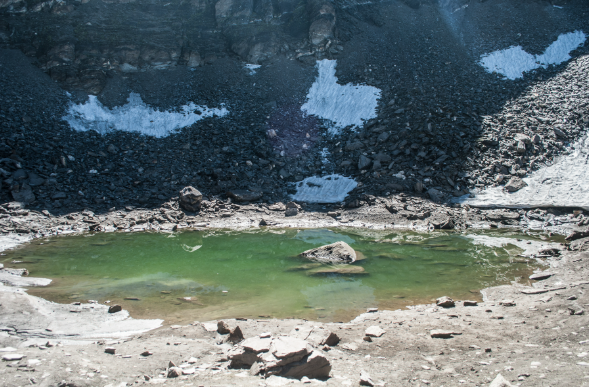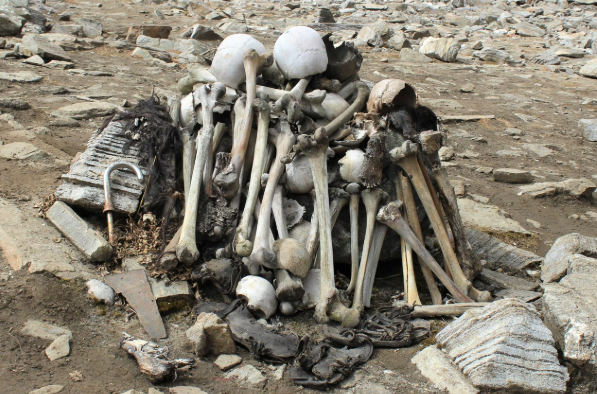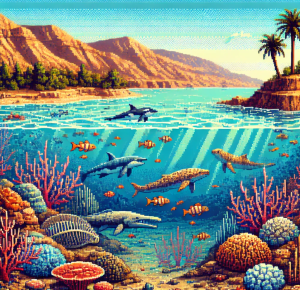
Hundreds of Skeletons in the Himalayas Came From Greece
High in the Indian Himalayas, 16,500 feet above sea level, lies a tiny alpine lake no bigger than a swimming pool. To casual hikers, Roopkund Lake looks like a jewel tucked among the peaks. But when the ice melts in summer, the shoreline reveals something shocking: scattered human skeletons. Hundreds of them.
For decades, this site, nicknamed “Skeleton Lake,” has baffled scientists and fueled legends. Were these people victims of an ancient battle? Struck down by the gods? Wiped out by a plague? Folklore even whispers of a wrathful goddess hurling hailstones the size of cricket balls at a sinful king and his entourage.
Now, thanks to cutting-edge DNA analysis and radiocarbon dating, scientists have uncovered answers stranger than the myths.
Not One Story, But Many
The first surprise? The skeletons don’t belong to a single doomed group. Ancient DNA from 38 individuals revealed three distinct genetic clusters.
- Group A: 23 people with ancestry typical of South Asia, dating back to around 800 CE.
- Group B: 14 people with ancestry most similar to Greeks and Cretans from the eastern Mediterranean, who died nearly 1,000 years later, around 1800 CE.
- Group C: A single individual with Southeast Asian ancestry, also dating to the later period.
That means Roopkund wasn’t the scene of one catastrophic event. It was a burial ground twice over, separated by centuries.

A Pilgrimage Gone Wrong?
For the earliest group, the likely explanation is tied to ritual. Roopkund lies along the path of the Nanda Devi Raj Jat pilgrimage, a sacred journey still undertaken today. Inscriptions from the 8th–10th centuries hint at early forms of this pilgrimage. Perhaps these travelers, men and women alike, perished during a festival, possibly caught in a brutal hailstorm.
But what about the later arrivals from the Mediterranean? That’s the real puzzle. Why would a group of people from Greece or Crete end up dying in the Himalayas in the 1800s?
Diets Tell Their Own Tale
Stable isotope testing on the bones revealed distinct eating habits. The South Asians ate a varied diet, including millet and other C4 crops. The Mediterranean group, by contrast, had a diet rooted in wheat, barley, and rice—staples of their homeland.
This was no mass migration of an army or family. These were unrelated men and women, foreigners far from home, with no clear ties to South Asia. Did they travel as pilgrims? Were they adventurers seeking the divine in distant mountains? Or perhaps a wealthy Ottoman-era caravan whose journey ended in tragedy? The scientific data leaves room for speculation, but rules out simple answers.
The Twist: No Epidemic, No Battle
One of the most striking findings is what wasn’t found. Researchers tested for ancient pathogens, signs of a plague or epidemic, but found nothing. They also found no close relatives among the dead, and the mix of men and women doesn’t fit the profile of a military unit.
Instead, the evidence suggests that groups of travelers, separated by geography, culture, and centuries, met their end in this isolated place. Roopkund Lake wasn’t a mass grave of war or disease. It was a waypoint where fate, weather, and circumstance left their mark across time.
Skeleton Lake as a Time Capsule
Consider this: one tiny Himalayan lake holds the stories of South Asian pilgrims from a millennium ago, Mediterranean wanderers from just a few centuries ago, and even a lone Southeast Asian traveler. That’s like opening a time capsule and finding snapshots from different eras, stitched together by geography and mystery.
It’s a reminder of how global history has always been. Pilgrims, traders, and travelers crossed borders long before the modern age of globalization. The Himalayas weren’t an impassable barrier; they were a crossroads.
Let’s Explore Together
First, here’s a great video on Roopkund
The Roopkund discovery shows how science can peel back layers of myth to uncover something even more astonishing. Instead of one tragedy, there were many. Instead of a single culture, multiple continents converged in the shadow of Nanda Devi.
So here’s where you come in:
- How do you see this research changing the way we think about ancient travel and connection?
- If you could time-travel to uncover one mystery site in the world, which would you choose?
Share your thoughts! Every conversation weaves a little more into the grand story of human history.



